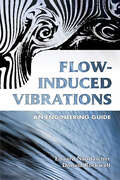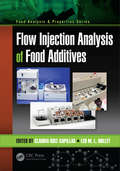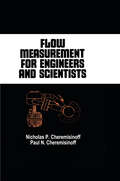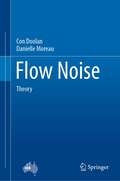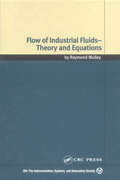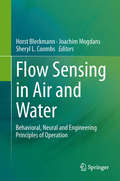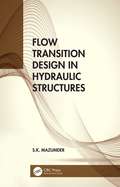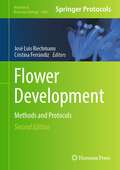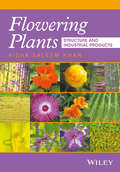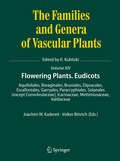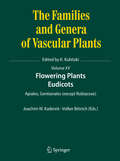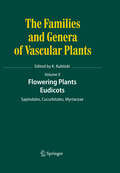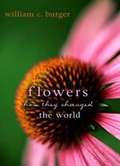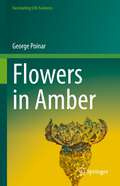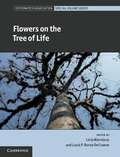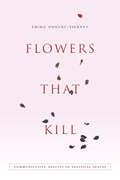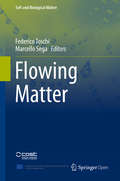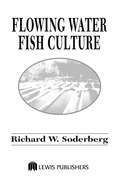- Table View
- List View
Flow-Induced Vibrations: An Engineering Guide (Dover Civil and Mechanical Engineering #7)
by Eduard Naudascher Donald RockwellDespite their variety, the vibration phenomena from many different engineering fields can be classified into a relatively few basic excitation mechanisms. The classification enables engineers to identify all possible sources of excitation in a given system and to assess potential dangers. This graduate-level text presents a synthesis of research results and practical experience from disparate fields in the form of engineering guidelines. It is particularly geared toward assessing the possible sources of excitation in a flow system, in identifying the actual danger spots, and in finding appropriate remedial measures or cures.Flow-induced vibrations are presented in terms of their basic elements: body oscillators, fluid oscillators, and sources of excitation. By stressing these basic elements, the authors provide a basis for the transfer of knowledge from one system to another, as well as from one engineering field to another. In this manner, well-known theories on cylinders in cross-flow or well-executed solutions from the field of wind engineering--to name just two examples--may be useful in other systems or fields on which information is scarce. The unified approach is broad enough to permit treatment of the major excitation mechanism, yet simple enough to be of practical use.
Flow Injection Analysis of Food Additives (Food Analysis & Properties)
by Leo M. L. NolletFlow Injection Analysis of Food Additives gives you the tools you need to analyze food and beverage additives using FIA. This sets it apart from other books that simply focus on the theoretical basis and principles of FIA or on the design of equipment, instrumentation, manifold, and setting mechanism. Truly unprecedented in its scope, this book rep
Flow Measurement for Engineers and Scientists (Chemical Industries Ser. #32)
by Nicholas P. Cheremisinoff Paul N. CheremisinoffThis book discusses instrumentation and experimental methods for obtaining detailed information on the structure of various types of flows as well as standard process flow instrumentation suitable for industrial control applications. It assists research-oriented and process engineering personnel.
Flow Noise: Theory
by Con Doolan Danielle MoreauThis book highlights the importance of sound produced by fluid flow or flow-induced noise. Noise created by unsteady flow creates high levels of environmental noise pollution, a known public health problem, and can compromise the acoustic qualities of marine vessels. There is a seemingly ever-growing list of modern technology that created flow-induced noise which includes aircraft, wind turbines, submarines, drones, high-speed rail, and cooling fans. More scientists and engineers are required to incorporate the effects of flow-induced noise in their work. This book also provides a comprehensive introduction to the theory underpinning the understanding of flow-induced noise.
Flow of Industrial Fluids: Theory and Equations
by Raymond MulleyWith a novel approach that bridges theory and practice, this book uses a uniquely structured series of chapters and appendices to present the basic theory and equations of fluid flow with just the right amount of detail and discussion. Full derivations and explanations are relegated to chapter-specific appendices, making both aspects easier to access. The treatment is also organized to allow the more complex compressible flow theory and associated equations to build on the less complex. Anyone who must deal with industrial flow processes, equipment, or piping systems will find that this book effectively links theory to practice and builds the kind of insight they need to solve real-world problems.
Flow Perturbation Gas Chromatography
by A. KatsanosThis book discusses flow perturbation method, namely, the stopped-flow technique and the reversed-flow technique. It is directed to those who need an accurate method for the determination of a certain physicochemical quantity and to researchers working on the development of gas chromatography.
Flow Sensing in Air and Water
by Horst Bleckmann Joachim Mogdans Sheryl L. CoombsIn this book, leading scientists in the fields of sensory biology, neuroscience, physics and engineering explore the basic operational principles and behavioral uses of flow sensing in animals and how they might be applied to engineering applications such as autonomous control of underwater or aerial vehicles. Although humans possess no flow-sensing abilities, countless aquatic (e. g. fish, cephalopods and seals), terrestrial (e. g. crickets and spiders) and aerial (e. g. bats) animals have flow sensing abilities that underlie remarkable behavioral feats. These include the ability to follow silent hydrodynamic trails long after the trailblazer has left the scene, to form hydrodynamic images of their environment in total darkness, and to swim or fly efficiently and effortlessly in the face of destabilizing currents and winds.
Flow Transition Design in Hydraulic Structures
by S.K. MazumderTransitions are provided in hydraulic structures for economy and efficiency. This book covers all types of flow transitions: sub-critical to sub-critical, sub-critical to super critical, super-critical to sub-critical with hydraulic jump, and super-critical to super-critical transitions. It begins with an introduction followed by characteristics of flow in different types of transitions and procedures for hydraulic design of transitions in different structures. Different types of appurtenances used to control flow separation and ensure uniform flow at exit of transition and diffusers are included. Examples of hydraulic design of a few typical hydraulic structures are given as well.
Flower Day: A Story of 24 Hours and 24 Floral Lives (Earth Day)
by Sandra KnappAn illustrated hourly guide that spotlights twenty-four flowers as they attract pollinators, resist predators, and survive on our changing planet. Is it 4 AM or chicory o’clock? In this short book, botanist and award-winning author Sandra Knapp walks us through a day in a global garden. Each chapter of Flower Day introduces a single flower during a single hour, highlighting twenty-four different species from around the world. Beginning at midnight in the Americas, we spot the long tubular flowers of the moonflower, Ipomoea alba; they attract a frenzy of hawk moths before the dawn arrives and the flowers wither and collapse. As day breaks, dandelions and chicory open their heads—actually made up of many individual flowers tightly packed together—and flies and bees visit to get the energy they need to lay eggs and raise their young. Later, at eight o’clock in the morning, the sun rises over the watery Amazon basin, and we meet the giant waterlily, slowly turning from white to pink and purple. Trapped inside are the beetles who feasted on the flowers during the night. That evening, at seven o’clock, we travel to the Caribbean to smell night-blooming jessamine’s powerful—some may say nauseating—sweet scent. But this member of the nightshade family isn’t just a thing of beauty—it has a reputation as both a poison and invasive species, crowding out endangered native trees. For each hour in our flower day, celebrated artist Katie Scott has depicted these scenes with gorgeous pen-and-ink illustrations. Working closely together to narrate and illustrate these unique moments in time, Knapp and Scott have created an engaging read that is a perfect way to spend an hour or two—and a true gift for amateur botanists, gardeners, and anyone who wants to stop and appreciate the flowers.
Flower Development: Methods and Protocols (Methods in Molecular Biology #2686)
by José Luis Riechmann Cristina FerrándizThis second edition details new and updated protocols for experimental approaches that are currently used to study the formation of flowers. Chapters guide readers on genetic methods, phenotypic analyses, genome-wide experiments, modeling, and system-wide approaches. Written in the highly successful Methods in Molecular Biology series format, chapters include introductions to their respective topics, lists of the necessary materials and reagents, step-by-step, readily reproducible laboratory protocols, and key tips on troubleshooting and avoiding known pitfalls. Authoritative and cutting-edge, Flower Development: Methods and Protocols, Second Edition aims to be a useful and practical guide to new researchers and experts looking to expand their knowledge.
Flowering Plants: Structure and Industrial Products
by Aisha S. KhanAngiosperms, or flowering plants, are one of the most diverse plant groups on the planet, and they offer tremendous resources for a broad range of industries. Flowering Plants examines the anatomy and morphology of angiosperms with a focus on relating their metabolic activities to products for the pharmaceutical, food, cosmetic, and textile industries. This up-to-date reference provides a thorough understanding of plant structure and chemical and molecular processes found in angiosperms. It covers many important topics on applied botany, and therefore, can also be used as a textbook for students of related fields. It details the latest research in the field, along with areas in need of further study, for students, researchers, and professionals working in industry. The book takes advantage of technological innovations to showcase a range of advanced techniques for studying plant structure and metabolites, such as cryo-electron microscopy, ultramicroscopy, x-ray crystallography, spectroscopy, and chromatography. Filled with helpful illustrations, diagrams, and flowcharts to aid comprehension, Flowering Plants offers readers the morphological, anatomic, and molecular knowledge about angiosperms they need for a range of industrial applications.
Flowering Plants. Eudicots
by Joachim W. Kadereit Volker BittrichThis volume covers theorders Boraginales, Garryales and Solanales (except Convolvulaceae) of theLamiids (Asterids I) as well as three unplaced families of that clade, i. e. Vahliaceae, Icacinaceae and Metteniusaceae, and the orders Aquifoliales,Escalloniales, Bruniales, Dipsacales and Paracryphiales of the Campanulids(Asterids II). It is the first of two final volumes to (almost) complete thetreatment of the Asterids, which started with Vol. VI (Cornales, Ericales,2004) and continued with Vol. VII (Lamiales, 2004) and Vol. VIII (Asterales,2007). The present volume provides descriptions for 35 families and altogether340 genera, including three genera of somewhat uncertain family affiliation. Itprovides identification keys for families within orders and for all generawithin families, and also discusses probable phylogenetic relationships. Thewealth of information contained in this volume makes it an indispensable sourcefor all those working in pure and applied plant sciences.
Flowering Plants. Eudicots: Apiales, Gentianales (except Rubiaceae) (The Families and Genera of Vascular Plants #15)
by Joachim W. Kadereit Volker BittrichThis volume covers the orders Apiales (Asterids I) and Gentianales (except Rubiaceae; Asterids II). It is the last of five volumes to (almost) complete the treatment of the Asterids in this series after publication of Vols. VI (Cornales, Ericales, 2004), VII (Lamiales, 2004), VIII (Asterales, 2007) and XIV (Aquifoliales, Boraginales, Bruniales, Dipsacales, Escalloniales, Garryales, Paracryphiales, Solanales, Icacinaceae, Metteniusaceae, Vahliaceae, 2016). The present volume provides descriptions for 11 families with altogether 1021 genera. Identification keys are provided for families within orders and for all genera within families, and likely phylogenetic relationships are discussed. The wealth of information contained in this volume makes it an indispensable source for all working in pure and applied plant sciences.
Flowering Plants. Eudicots
by Klaus KubitzkiThis volume presents systematic treatments for the families and genera of the Malpighiales, which more recently have been recognised as a new major group of the eudicots. Apart from several herbaceous lineages (already treated in Vol. IX of this series), the order consists mainly of rainforest trees, particularly those of the understorey. Accompanied by other early eudicot lineages, this reflects the well-documented origin of the group as invaders into the conifer-, cycad- and seed fern-dominated forests of the Cretaceous which, at that time, were transformed into the tropical rainforest biome. In this volume, 24 families with 429 genera comprising over 12,000 species are treated. Many of these belong to the vast family of the Euphorbiaceae (here conceived in a broader sense), followed by the Violaceae, whereas some of the remaining families are very small and even relictual. The revised classification includes a complete inventory of the genera belonging to the families treated in this volume, along with their diagnostic features and keys for their identification. References to the latest taxonomic literature and links to many different disciplines important to modern plant systematics make the volume a valuable source of information on the manifold aspects of plant diversity.
Flowering Plants. Eudicots
by Job Kuijt Bertel HansenIn the present volume taxonomic treatments including descriptions of and keys to the families and genera for the orders Santalales and Balanophorales are offered, the former group here comprising 12 families with 162 genera and about 2100 species, and the latter with the single family Balanophoraceae composed of 16 genera and about 42 species. The contentious family classification of Santalales has been thoroughly revised against the background of previous classifications as well as available structural and molecular evidence, and also the classification of Balanophoraceae has been carefully updated. Santalales are predominantly hemiparasites connected with either the branches or the roots of other green land plants, whereas Balanophoraceae are holoparasites that form terrestrial tubers attached to the roots of woody hosts. In both orders, parasitism has led to considerable reductions of the vegetative and reproductive organs and detailed descriptions are given on the initiation of ramal and terrestrial parasitism in Santalales and the haustorial connection and tissue continuity between host and parasite in both groups. The dramatic reduction of the vegetative body in Balanophoraceae, which may lack all vegetative organs typically found in green land plants, has promoted studies in the field of developmental morphology. Thus, the volume not only provides an overview of the diversity of the plant groups treated therein, but also points to the interesting biological peculiarities that have evolved in connection with their singular lifestyle.
Flowers: How They Changed the World
by William C. BurgerThe world would be a pretty drab place without flowers. Their bright cheery colors help make our natural environment a more delightful place to be. But flowers in all their beautiful variations didn't evolve just for the viewing pleasure of the later-developing human race. What are flowers really for? As botanist and popular science writer William Burger makes clear in this enchanting book, the quick and simple answer is: sex. Burger emphasizes the essential role that flowers play in life's evolutionary scheme. Their bright colors and alluring shapes represent a strategy for attracting insects and inducing animals to help with pollination. This constant intermingling is nature's way of perpetuating the species and encouraging variety, so as to protect against disease and unpredictable environments. Flowers are the supreme example of nature's reproductive exuberance, ensuring the persistence of life against an onslaught of destructive forces.More significantly, Burger points out, flowers are the fundamental energy resource for most of the biosphere. Since they energize themselves by capturing the energy of sunlight, they provide a vital link in the chain of life, especially for animals and humans, which depend on other organisms to nourish and energize them. Without the existence of flowering plants, human survival would be in jeopardy. Finally, Burger goes on to show the paramount importance of a few species of plants that have served not only as the basis of agriculture, but, in doing so, have enabled human civilization to thrive. Even today, in our complex technological world, it is the flowering plants that provide us with nearly all the vegetable energy that sustains us. Written with clarity, wit, and engaging enthusiasm for the marvels of our fragile ecosystem, Flowers will make you stop and smell the roses, with a new appreciation of their crucial role in the web of life.
Flowers: Investigate The Colorful World Of Flowers, Fruits, And Seeds (Nature Explorers)
by DKA first nature book about flowers for children, this is the perfect companion for young minds eager to learn about the world of flowering plants.Children are encouraged to investigate and record all the wildflowers they find and get hands on with the fun activities, from pressing petals to preserve them to making a mini desert filled with cacti.With a mix of fantastic photographs and beautiful illustrations Flowers takes you through everything you need to know about these beautiful blooms. Learn which plants flower and which don't, how pollinators help plants make seeds, and what the parts of a flower are.The Nature Explorers series is essential for any child curious about the world outside. Each book in the series takes children through the basics of the subject, starting by explaining what it is and then moving on to the key topics. These are wonderful introductions to the great outdoors, packed with fun facts and engaging activities, ideal for children aged 6 and up.
Flowers Are Calling
by Rita GrayIn this rhyming poetic picture book, explore the wonders of natural cooperation between plants, animals and insects. Flowers Are Calling by Rita Gray and illustrated by Kenard Pak is "a sophisticated blend of scientific information and artistry" (Publishers Weekly).Flowers are calling to all the animals of the forest, "Drink me!"—but it’s the pollinators who feast on their nectar.In rhyming poetic form and with luminous artwork, this book shows us the marvel of natural cooperation between plants, animals, and insects as they each play their part in the forest's cycle of life.
Flowers in Amber (Fascinating Life Sciences)
by George PoinarWhile much attention has been given to animal life in amber, the remains of a variety of plants, including angiosperm flowers, also exist in fossilized resin. Presented here is a pictorial synopsis of 94 flowers that occur in four major amber deposits around the world. These deposits are from Burma (Myanmar), the Baltic area, the Dominican Republic and Mexico, and range in age from the mid-Cretaceous to the mid-Tertiary. The basic features of these flowers are presented and their relationship with existing plant lineages discussed. This work will be of interest to amber enthusiasts, plant taxonomists, plant morphologists, plant ecologists, plant evolutionists and plant paleontologists.
Flowers on the Tree of Life
by Livia Wanntorp Louis P. Ronse De CraeneGenetic and molecular studies have recently come to dominate botanical research at the expense of more traditional morphological approaches. This broad introduction to modern flower systematics demonstrates the great potential that floral morphology has to complement molecular data in phylogenetic and evolutionary investigations. Contributions from experts in floral morphology and evolution take the reader through examples of how flowers have diversified in a large variety of lineages of extant and fossil flowering plants. They explore angiosperm origins and the early evolution of flowers and analyse the significance of morphological characters for phylogenetic reconstructions on the tree of life. The importance of integrating morphology into modern botanical research is highlighted through case studies exploring specific plant groups where morphological investigations are having a major impact. Examples include the clarification of phylogenetic relationships and understanding the significance and evolution of specific floral characters, such as pollination mechanisms and stamen and carpel numbers.
Flowers on the Tree of Life
by Livia Wanntorp Louis Ronse De CraeneGenetic and molecular studies have recently come to dominate botanical research at the expense of more traditional morphological approaches. This broad introduction to modern flower systematics demonstrates the great potential that floral morphology has to complement molecular data in phylogenetic and evolutionary investigations. Contributions from experts in floral morphology and evolution take the reader through examples of how flowers have diversified in a large variety of lineages of extant and fossil flowering plants. They explore angiosperm origins and the early evolution of flowers and analyse the significance of morphological characters for phylogenetic reconstructions on the tree of life. The importance of integrating morphology into modern botanical research is highlighted through case studies exploring specific plant groups where morphological investigations are having a major impact. Examples include the clarification of phylogenetic relationships and understanding the significance and evolution of specific floral characters, such as pollination mechanisms and stamen and carpel numbers.
Flowers That Kill: Communicative Opacity in Political Spaces
by Emiko Ohnuki-TierneyFlowers are beautiful. People often communicate their love, sorrow, and other feelings to each other by offering flowers, like roses. Flowers can also be symbols of collective identity, as cherry blossoms are for the Japanese. But, are they also deceptive? Do people become aware when their meaning changes, perhaps as flowers are deployed by the state and dictators? Did people recognize that the roses they offered to Stalin and Hitler became a propaganda tool? Or were they like the Japanese, who, including the soldiers, did not realize when the state told them to fall like cherry blossoms, it meant their deaths? Flowers That Kill proposes an entirely new theoretical understanding of the role of quotidian symbols and their political significance to understand how they lead people, if indirectly, to wars, violence, and even self-exclusion and self-destruction precisely because symbolic communication is full of ambiguity and opacity. Using a broad comparative approach, Emiko Ohnuki-Tierney illustrates how the aesthetic and multiple meanings of symbols, and at times symbols without images become possible sources for creating opacity which prevents people from recognizing the shifting meaning of the symbols.
Flowing Matter (Soft and Biological Matter)
by Federico Toschi Marcello SegaThis open access book, published in the Soft and Biological Matter series, presents an introduction to selected research topics in the broad field of flowing matter, including the dynamics of fluids with a complex internal structure -from nematic fluids to soft glasses- as well as active matter and turbulent phenomena. Flowing matter is a subject at the crossroads between physics, mathematics, chemistry, engineering, biology and earth sciences, and relies on a multidisciplinary approach to describe the emergence of the macroscopic behaviours in a system from the coordinated dynamics of its microscopic constituents. Depending on the microscopic interactions, an assembly of molecules or of mesoscopic particles can flow like a simple Newtonian fluid, deform elastically like a solid or behave in a complex manner. When the internal constituents are active, as for biological entities, one generally observes complex large-scale collective motions. Phenomenology is further complicated by the invariable tendency of fluids to display chaos at the large scales or when stirred strongly enough. This volume presents several research topics that address these phenomena encompassing the traditional micro-, meso-, and macro-scales descriptions, and contributes to our understanding of the fundamentals of flowing matter. This book is the legacy of the COST Action MP1305 “Flowing Matter”.
Flowing Water Fish Culture
by Richard W. SoderbergFlowing Water Fish Culture provides an in-depth discussion of the husbandry of fin fish in a stream of water. It guides the reader through the technical considerations of intensive aquaculture, including fish growth rates, hydraulic characteristics of fish rearing units, oxygen consumption rates in relation to oxygen solubility and fish tolerance of hypoxia, and water reconditioning by reaeration and ammonia filtration. Unlike other publications that provide only general overviews on the subject, this text/reference offers specific details that will be useful in the actual design and operation of a facility. Problem sets at the end of each chapter provide ample opportunity to develop skills. The information in the book is valuable for those teaching, considering, or practicing aquaculture at intensity levels ranging from conventional single-pass trout hatcheries to closed aquaculture systems.
Flows and Chemical Reactions
by Robert K. Prud'HommeThe aim of this book is to relate fluid flows to chemical reactions. It focuses on the establishment of consistent systems of equations with their boundary conditions and interfaces, which allow us to model and deal with complex situations.Chapter 1 is devoted to simple fluids, i.e. to a single chemical constituent. The basic principles of incompressible and compressible fluid mechanics, are presented in the most concise and educational manner possible, for perfect or dissipative fluids. Chapter 2 relates to the flows of fluid mixtures in the presence of chemical reactions. Chapter 3 is concerned with interfaces and lines. Interfaces have been the subject of numerous publications and books for nearly half a century. Lines and curvilinear media are less known Several appendices on mathematical notation, thermodynamics and mechanics methods are grouped together in Chapter 4.This summary presentation of the basic equations of simple fluids, with exercises and their solutions, as well as those of chemically reacting flows, and interfaces and lines will be very useful for graduate students, engineers, teachers and scientific researchers in many domains of science and industry who wish to investigate problems of reactive flows. Portions of the text may be used in courses or seminars on fluid mechanics.
